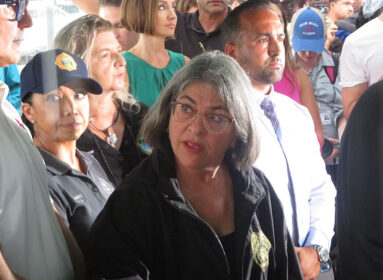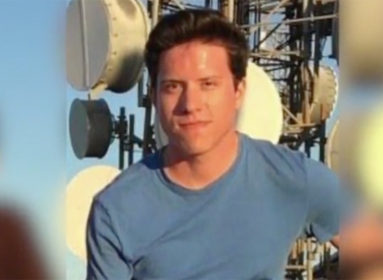
By Cindy Mindell
Rabbi Yitzchok Moully’s journey from the Australian outback to the heart of the Chabad world and a silkscreening studio is as full of color as his vibrant, neon-hued artwork. Ordained in Venice, Italy in 2002, Moully is the founder of The Creative Soul, a Jewish art organization that promotes creativity and emerging artists in the Orthodox and Chassidic communities. Moully’s curated multi-artist exhibition, “Chassidim of Color,” was featured on an Oprah’s Next Chapter exploration of the Chassidic community of Crown Heights in 2012. Largely self-taught, the painter and silkscreen artist is a student of Philip Sherrod. He lives in Basking Ridge, N.J. with his wife Batsheva and their five children.
Moully will speak about his art and facilitate a children’s silkscreen workshop on Sunday, June 14 at the Bridgeport Community Kollel.
He spoke with the Ledger about his life as the Pop Art Chassidic rabbi in the orange socks.
Q: How did you find the Chassidic community and start your artistic journey?
A: My parents were hippies in Darwin, Australia, which is kind of like the capital of nowhere. I was growing up on a commune, on a raw food diet – very alternative and connected to nature. My mother’s parents are from Egypt, my father’s side is from Australia and the generation before that from Eastern Europe and Scotland. My parents’ Jewish upbringing was traditional: my grandparents drove to synagogue and kept kosher in the house. My parents were spiritual but they weren’t practicing.
When I was young, my grandfather was not well, living in Melbourne, and so we came down to be with the family. He was not well for a while, he was in and out of hospital, and coming [back and forth] from the outback to suburbia was a huge expense. So, my mother enrolled me in the local Melbourne Jewish day school, which is a Chabad day school. My first day was the day my grandfather passed away. It was as though he was holding on and waiting and trying to draw us down from Queensland to be in a more Jewish environment. And he achieved that.
We were there for about a year and my parents were getting antsy. At that point, going back to the outback wasn’t a great idea; it wasn’t a place for a family that was beginning their Jewish journey. We decided the best place in the world to be would be religious kibbutz in Eretz Yisrael, where we could have a love of the land, of nature, and a love of Judaism. The plan was to get to Israel via Los Angeles and New York. We stopped in Brooklyn for 10 days, just before Rosh Hashanah and Yom Kippur and we were put up by complete strangers in the Crown Heights section. Someone said, “You’re on your Jewish journey, your life journey, you’re at a crossroads – write a letter to the Lubavitcher Rebbe, a great man who has soul wisdom and can guide you appropriately.”
My parents wrote to the Rebbe and he said, “Stay for the time being and accomplish what you’re here to accomplish.” So, what started off as 10 days became four-and-a-half years. If not for those four-and-a-half years, I would be, as we say in Australian slang, “a bloody good surfer.” And I know my nature and tendency: I wouldn’t be married, I wouldn’t have a job, I wouldn’t have kids; it would be just me and the waves.
Looking back, I felt that there was something in me, in my parents, that the Rebbe saw, that was worth cultivating. Throughout my life and growing older, I thought it was to be a card-carrying member of the Chabad community, to be a Chabad rabbi – a shaliach [emissary].
We went back to Melbourne, I went to the elementary school, high school, and yeshiva there, then the rabbinical college in Australia, followed by the rabbinical college in Morristown, N.J. Today, my parents are part of the Chabad community in Melbourne. I ended up in Basking Ridge [N.J.] once I got married to my beautiful wife from Toronto, serving as the youth rabbi. I thought this was the be-all-and-end-all, achieving my mission in life.
That was all fine until one night, I was on the Internet and I saw this thing called silkscreen and it blew my mind and right then and there I said, “I can do this.”
Q: Were you already interested in art?
A: The truth is that I’m not a great drawer; I’m a little intimidated to draw, and I never saw myself as an artist. My mother tells me that I was a very horrible art student because I never complied with what they wanted. But I was definitely artistic and I had an artistic bent, and photography was my way of expression. At the time, it was just on the cusp of digital, and sometimes I felt that photography was too real; there was no room for interpretation – what you see is what you get. In the silkscreen process, you can take a photo and develop it further and create a more painterly effect and do more with it.
I jumped right in. I had no idea what I was doing and it took me about 12 months to produce my first piece. I was completely self-taught, and I tried and failed and gave up and tried and failed and gave up and went to this silkscreen place and that silkscreen place and was finding commercial silkscreen people who had no room and no patience for an artist who had no idea what he was doing. But eventually I finished my first piece and my second piece and stood back and said, “Wow, I’m really onto something; I can really do this.”
Q: How did you merge your Judaism and art?
A: Stage two of my journey was developing my art and expression. That led me to the existential question, what’s a good Jewish rabbi doing painting? I had gotten some nice press early on from The Forward and the local papers; I worked with the ArtisZen Arts gallery in Lambertville, N.J. My tagline was “Rabbi by day, artist by night.”
I thought, is this appropriate? Should I be spending so much time painting? It’s self-fulfilling and I’m enjoying it and it’s my expression, but is this an appropriate use of time and does this fit into the structure of life? I asked my personal mentor rabbi and he said, “The question isn’t should you paint but how? God gave you this gift. How can you use this gift to serve God and humanity, and to bring other people closer to God and humanity?”
It was a real paradigm shift to recognize that. It’s not about my expression or artistic ability but it’s about the message that I’m conveying through my work. I take concepts and ideas from Chassidic thought, from Torah, and I try to convey them in my work as best I can. One primary, elemental idea is the joy of and the joy in Judaism. Like I say, there’s a lot of color under that black hat.
Q: I’m thinking of your work, Orange Socks.
A: Chassidim are seen as very stoic and straight and rigid, but really, there’s a lot of color. One of the fundamental things I’m trying to do is convey that this isn’t your grandfather’s Jewish art. It’s fun and engaging. Orange Socks sums up everything that I’m trying to achieve. In some ways, it’s my self-portrait: I wear orange socks when I’m not wearing yellow or green. I wore orange socks to my wedding.
That image is a group of rabbis, men, all walking, and they’re all lockstep and in line and following the straight-and-narrow. And at the same time, there’s one man who has personalized his Judaism and made it his own. He doesn’t need dreadlocks or tattoos to define his individuality. It’s the norm but it’s personalizing one’s Judaism. We all have the same 613 mitzvot and the same covenant and commandments, the same structure. But within that structure, we have to make it our own, we have to personalize it, we have to live it – not as an outside influence on us but as an expression of who we are. The orange socks are really a central fundamental.
Part of this phase was the realization that I had a message to share. I’m no longer a full-time Chabad youth rabbi because I got more and more involved in the arts and realized that I had more and more to give. I couldn’t be in two places at once, emotionally and mentally. Now I loosely call myself the ‘Art Rabbi.’ I try to connect and inspire Jews through art and I’ve started going on tour.
Q: As an observant Jew, what are you not allowed to incorporate into your art?
A: I like to look at it the other way: what you can explore. People say, “You only paint Jewish themes.” I have my Tree of Life series, which is as Jewish as you want it to be and as pluralistic as you want. I paint what I am passionate about and it just happens to be that I’m passionate about my Judaism. The natural world is fair game. What isn’t open is [related to] the laws of modesty, so painting nudes is out, as are other religions – depicting Jesus and so on. That was Asher Lev’s department; I’ll leave that to him.
I’m looking to speak and share with everyone across the Jewish scene. I would love to get into as many Reform, Conservative, and Reconstructionist temples, JCCs, Jewish federations, Hebrew day schools, just to share this idea of using creativity as a means to dialog about Judaism – not come to any conclusions – but to dialog about what it means to each of us. Creativity and artistry are platforms to further that conversation.
I have three bodies of work: my early silkscreen, my “Pop Art” and what I call “Post-Pop,” where I take a silkscreen image and paint around it to create more of a multimedia effect, and then I have complete abstract.
Q: What does your mentor rabbi think of your work?
A: He loves it. I’m going to Denver to do an event that he set up. I can touch people through my art in a way that a pulpit rabbi cannot. For better or worse, people have certain preconceived notions and assumptions and previous experiences with rabbis and, unfortunately, there’s a certain standoffishness. Art has an ability to engage in a way that a pulpit rabbi cannot. It’s a non-threatening environment to really begin a dialog in. It’s my Judaism that I’m trying to channel. I have my voice, and I find different media to help me say what I’m trying to say, and to convey Judaic and Chassidic concepts. I have a Pop series called “Ritual Objects:” a martini glass and a Kiddush cup, a Zippo lighter and Shabbat candles, a Chumash and an iPad displaying the opening words of the Torah.
The series is about how the physical world is a tool for us to live in a spiritual way, to take mundane objects and make them better and holier. That’s a concept going back to the Ba’al Shem Tov and even before. It’s a Kabbalistic idea, going back to Sinai, of taking a piece of parchment and writing the Torah on it and rolling it up and putting it on your doorpost or into tefillin. Now this object, this parchment, becomes holy. If something happens to it, you bury it as opposed to just discarding it.
This is what God put us on earth to do: to take the physical world and make it holy. If you were traveling, you could take a Zippo lighter and make the blessing to light Shabbat candles.
In some respects, it could be hiddur mitzvah – beautifying a mitzvah. It’s a matter of perspective. I would say that using a Zippo lighter in a way you didn’t expect is bringing a mitzvah to an object. Others would argue that hiddur mitzvah is specifically with beautiful silver candlesticks and anything less is not hiddur mitzvah. But I’m trying to turn it on its head and see things from a different perspective. n
“Fine Wine and Art” featuring Yitzchok Moully and wine expert Shlomo Blashka: Sunday, June 14, 4:30 p.m., Bridgeport Community Kollel, 85 Arlington St., Bridgeport. For tickets and/or information: bridgeportkollel.com.
Comments? email cindym@jewishledger.com.








 Southern New England Jewish Ledger
Southern New England Jewish Ledger


















